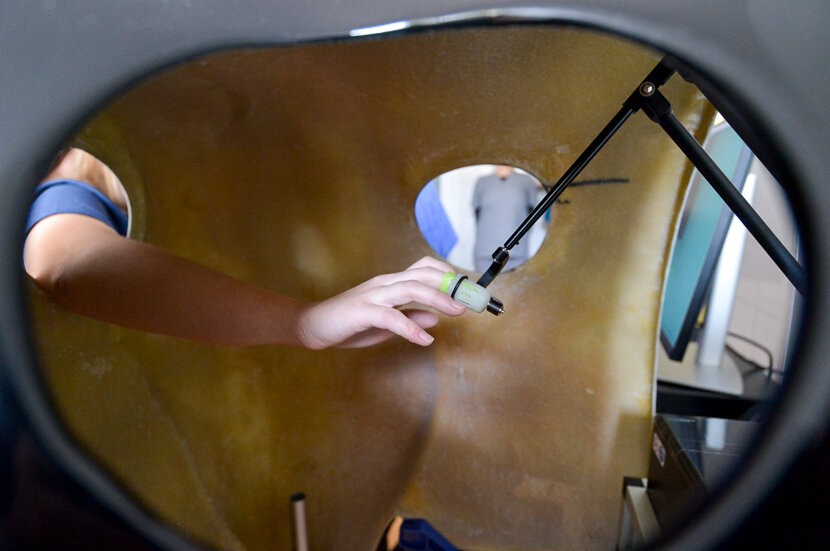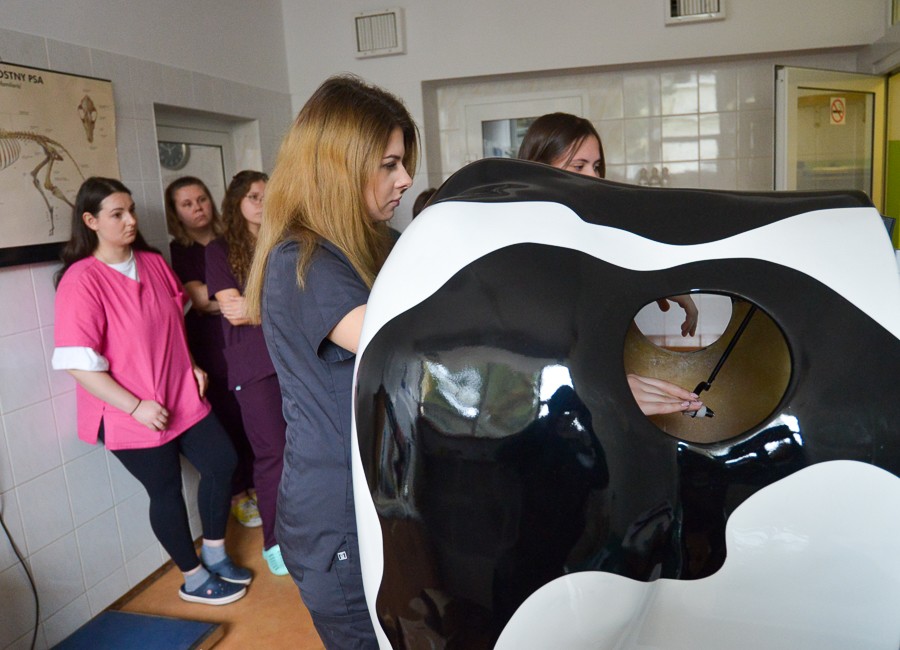
Welfare-first learning with touch technology
Large-animal simulation with immediate feedback that enhances the student learning experience.
Large-animal simulations with live feedback
Haptic Cow and Haptic Horse are state-of-the-art veterinary simulation systems that allow students to carry out virtual examinations of a cow or horse, long before their first contact with a living animal.
Students have a unique opportunity to train with the systems, learning to palpate bovine or equine anatomy to diagnose fertility, pregnancies, and other conditions such as colic.
Both systems were conceptualised and developed by Prof Sarah Baillie from the University of Bristol, a veterinary surgeon with extensive teaching experience, who also has a degree in computer programming.

How does it work?
Students reach inside a fibreglass shell modelled after the animal’s rear end to touch a robotic arm. The arm uses haptic technology - changing forces, vibrations, and movement - to mimic the feel of the animal’s actual anatomy.
In the Haptic Cow, students palpate computer-generated virtual objects representing the uterus, ovaries, pelvis and abdominal structures.
In the Haptic Horse, students virtually examine the abdomen including the aorta, small and large intestine, spleen, kidney and bladder.
A range of different scenarios is available for the cow and horse, conveniently for the teacher ‘at the click of a button.’


Haptic Cow and Horse are used around the world
Backed by Virtalis’ long history of delivering pioneering virtual reality solutions, haptic animals are used around the world – including by the University of Cambridge, Michigan State University in the United States, the University of Adelaide in Australia, the University of Pretoria in South Africa, Utrecht University in the Netherlands, and Wrocław University in Poland.





Better outcomes for all
The concept is based on Prof Sarah Baillie’s doctorate thesis which showed that students taught with the simulator performed significantly better when examining real cows and set the task of locating the uterus compared to a control group – that is, skills learned with the simulator transferred to the real task.
In addition, students are overwhelmingly positive about the technology.
The essential tool for every veterinary school
Improved learning outcomes for veterinary students
Instructors can see the student’s movements on a screen i.e., inside the cow or horse (not possible with a live animal), and can direct their movements and provide live feedback. Students develop improved identification and palpation skills thanks to the efficient and effective teaching possible using the simulator.
Increased confidence learning in a risk-free environment
Because the Haptic Cow and Horse are powered by haptic technology and software, they provide a wide range of scenarios for students to practise. For example, they can try out diagnosing different conditions, starting out with basic examinations that are made more complex as students learn and build confidence.
Embedding skills early on for students
The large-animal simulation offered by Haptic Cow and Horse means that students can get experience of bovine and equine anatomy from an early stage in their education. Universities can also give students the chance to learn at all levels, from pre-clinical all the way to final year.
Consideration for animal welfare
With Haptic Cow and Horse, training can be used strategically to complement student learning on live animals. Students who learn with these large-animal simulators are better-prepared for practical examinations and can make better use of such learning opportunities.
Showpiece for educational institutions
The Haptic Cow and Horse systems are a real draw for any applicants looking for the best veterinary course for them. Universities can showcase the simulators at open days to demonstrate the benefits of learning with the technology during the veterinary degree.
Advanced Veterinary Simulations
Haptic Cow and Haptic Horse are state-of-the-art veterinary simulation systems that allow students to carry out virtual examinations of a cow or horse, long before their first contact with a living animal.
Replicates Realistic Animal Anatomy
Students reach inside a fibreglass shell modelled after the animal’s rear end to touch a robotic arm. The arm uses haptic technology - changing forces, vibrations, and movement - to mimic the feel of the animal’s actual anatomy.
Hands-On Learning
Students have a unique opportunity to train with the systems, learning to palpate bovine or equine anatomy to diagnose fertility, pregnancies, and other conditions such as colic.